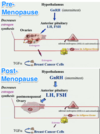Pharmacology-Breast Cancer Drugs Flashcards
(31 cards)
Why is nulliparity a risk factor for breast cancer?
Every time you go through the proliferative phase of the menstrual cycle breast cells proliferate and die off as estrogen levels fall. The more cycles a woman goes through, the greater the risk that one cell resists apoptosis and become cancerous.

How does estrogen actually stimulate proliferation of breast tissue?
Estrogen binds to estrogen receptor in nucleus -> Receptors dimerize and turn on transcription of TGF-alpha (transforming growth factor) -> Cells proliferate

Protective factors of breast cancer
Teen pregnancy, lactation and physical activity
Genetic associations with breast cancer
10% BRCA 1/2 (DNA repair & tumor suppressor) and p53 mutations (DNA repair and apoptosis). Note that multiple mutations are necessary to cause uncontrolled proliferation.
Chemotherapeutics used to treat breast cancer?
Cyclophosphamide (DNA strand breakage), MTX (decreased pyrimidine synthesis) and 5-FU (decreased pyrimidine synthesis)
How do you treat ER + breast cancer?
Antagonize estrogen receptors so estrogen from the ovary and estrone from the adrenal and fat cannot stimulate growth.

What anti-estrogen drug is a competitive antagonist in breast tissue but a competitive agonist in bone and endometrium and increases thromboembolic events?
Tamoxifen. In breast tissue to co-activators that recognize the conformation of estrogen do not recognize the conformation of tamoxifen. Instead co-repressors bind and TGF-alpha is inhibited.

Why might tamoxifen not work in some women?
It needs CYP2D6 for hepatic activation and some women may not have it. Also other drugs like fluoxetine and paroxetine (SSRIs) inhibit CYP2D6 and render tamoxifen ineffective.
Uses of tamoxifen
Treatment of breast cancer, prevent recurrence (best when used in conjunction with poly-chemo) and prevent breast cancer.
What demographic is tamoxifen most useful in?
Post-menopausal women with estrogen receptors in breast tissue.
What are the good and bad things you need to consider with tamoxifen?
*

Why should you use tamoxifen for no more than 5 years?
Tumor cells will begin to express co-activators that recognize tamoxifen and you will over-stimulate TGF-alpha and propagate tumor cell proliferation.

What anti-estrogen drug is a competitive antagonist in breast and uterine tissue but a competitive agonist in bone and lipid metabolism?
Raloxifene. Note that it is less likely to cause endometrial carcinoma and blood clots than tamoxifen.
SERM that is orally active (prodrug)?
Raloxifene.
What anti-estrogen drug is a pure estrogen receptor antagonist with no agonist effect in any tissue? What is it approved to be used for?
Fulvestrant (IM), it promotes ER degradation and prevents transcription of estrogen-sensitive genes. It is approved for used of ER + metastatic breast cancer in post-menopausal women with disease progression following tamoxifen.

Why are aromatase inhibitors recommended for post-menopausal women only?
They only fully inhibit aromatase in adipose tissue and partially block aromatase activity in the ovaries, allowing for continued estrogen stimulation by ovarian estrogen.

What drug inhibits side chain converting enzyme and is used to treat postmenopausal women who have metastatic breast cancer that progressed after tamoxifen treatment?
Aminoglutethimide. It limits production of all classes of steroids AND inhibits conversation of androgen into estrogen by aromatase in fat and muscle (but not so much in the ovaries). Note that this drug can also be used to treat Cushing’s.
What drug do you need to use for replacement when using aminoglutethimide?
Cortisol
What drug is better than aminoglutethimide and tamoxifen in treating initial and advanced breast cancer in postmenopausal women because of its specific action and minimal side effects?
Selective aromatase inhibitors: anastrozole, letrozole and exemestane. There is no effect on mineralocorticoid or glucocorticoid synthesis. There are no side effects of thromboembolism or endometrial carcinoma. It is about equal to fulvestrant in treating advanced breast cancer.
What drugs can be used to treat advanced breast cancer with an unknown mechanism and stimulate appetite to promote weight gain in cachectic patients?
Progesterone analogues: megestrol and medroxyprogesterone.
Progesterone antagonist that may be used to treat BRCA 1 associated breast cancer?
Mifepristone
What drug can be used to treat metastatic breast cancer in premenopausal women that allows for residual estrogen stimulation from adipose tissue?
Continuous administration of GnRH agonists (leuprolide, goserelin) will cause an initial spike in estrogen followed by a drop off once pituitary GnRH receptors are desensitized. Note that these are also used to treat male prostate cancer.

Adverse side effects of leuprolide and goserelin?
Ablation of sex steroid hormones causes hot flashes, sweating and nausea (like menopause).
Drug used to treat HER2/neu breast cancer?
Herceptin (trastuzumab), or pertuzumab: monoclonal antibodies that prevent dimerization of the HER2 tyrosine kinase receptor. Note that this is typically used in conjunction with chemotherapy.






